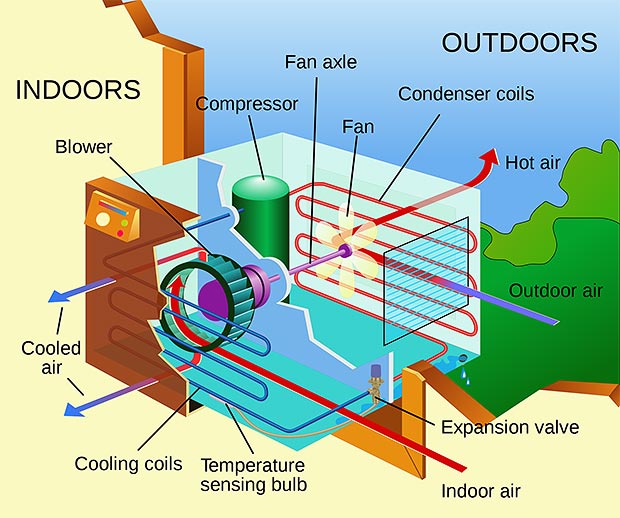Free guide to the different types of air conditioners.
Contents
- Types of Air Conditioners
- Air conditioners that heat a room
- Thermostatically controlled air conditioning units
- Dehumidifying and humidifying air conditioning systems
- Allergen removing air conditioners
- Portable and installed air conditioners
- Power saving and fossil fuel powered air conditioners
Types of Air Conditioners
Originally, air conditioners were designed in order to cool the rooms of a building.
The air conditioning machine was then improved to become a tool capable of doing a large number of tasks.
There are economy air conditioners bounding around the marketplace whose only purpose is cooling the air.
This is all well and good, but technology has advanced so far that now the term “air conditioning” means more than simply cooling air.
Read on a selection of different types of air conditioning systems available:
Air conditioners that heat a room
Many air conditioning machines may heat rooms. They function as an entire buildings heating system.
This is done via a reversible mechanism which pumps hot air into a room.
This may work in two ways; the first is through a system that draws air from outside and heats it as the air is drawn into the room.
The second way is to recycle the air in the room by blowing it past a heated filament.
Thermostatically controlled air conditioning units
These are the most commonly used air conditioning units in America.
They have a hot and cold air function that is controlled via a thermostat.
A temperature range is set via the thermostatic control, and the machine will heat or cool the air in the room to keep the temperature between the preset ranges.
Dehumidifying and humidifying air conditioning systems
There are units that act as dehumidifiers. These machines will heat or cool a room, whilst removing the water from air as it passes the heating/cooling filaments.
Of the same ilk, there are air con units that act as humidifiers. A terribly humid or exceeding dry heat is quite unpleasant.
This variety of air conditioning system is quite popular in areas where extremely dry or humid air is commonplace.
Allergen removing air conditioners
Some air conditioning machines have an allergen removal function.
There are machines that remove pollen from the air, and others that help to filter dust mites from the air.
They suck the air through filters, so that clean, filtered air is pumped back into the room.
Portable and installed air conditioners
Some air conditioning devices are portable, where as others condition the air in multiple rooms.
There are machines that are portable so the owner need not go to the expense of having one installed in every room of the building.
There are other more permanent units that can be installed.
A more permanent unit may be an unneeded expense if there are only a few people in the building at any one time.
A portable machine may be moved into whichever room is currently inhabited.
Larger installed machines condition the air in multiple rooms with just one machine.
The machine draws in and cools the air, and pumps the cold air into different rooms via a network of pipes and air ducts.
Modern units are sophisticated enough to allow temperature control in each room.
Power saving and fossil fuel powered air conditioners
Some varieties of air con unit are power saving, while others are powered with fossil fuels such as oil, petrol and diesel.
More and more air conditioners are becoming increasingly energy efficient, and through careful air recycling, there are heaters that run on half the power they did ten years ago.
Fossil fuel powered air conditioners heat the room by burning the fuel to produce heat.
The unit will cool the air using electricity generated within the machine to power a compressor.
The pump, which circulates the air with a fan, is also powered with the electricity generated by the fossil fuel powered generator.
Most air conditioning units are electricity powered. These are the most common types of air conditioners.
They use filaments to heat the air and compressors to cool the air.
There are solar powered machines that charge whilst the sun is up, to produce either cold or warm air.
There are also geothermal units. These air conditioners work by burying an exceptionally long pipe in a very deep hole.
Cold water is pumped down into the pipe, and the water heats up in transit; returning hot water which then circulates around a radiator system.

